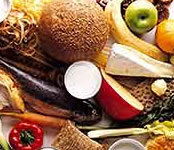| |
 In order to achieve your nutritional needs all of
your life it is important to consider consuming a variety
of foods that will help you achieve your daily requirements
of vitamins and minerals. We all know that consuming
a wide range of vitamins and minerals can provide us
with protection against disease and increase our life
span. But before making any significant changes to your
diet it is important to consult with your doctor first. In order to achieve your nutritional needs all of
your life it is important to consider consuming a variety
of foods that will help you achieve your daily requirements
of vitamins and minerals. We all know that consuming
a wide range of vitamins and minerals can provide us
with protection against disease and increase our life
span. But before making any significant changes to your
diet it is important to consult with your doctor first.
What does food variety mean?
Variety means choosing to eat a mixture of nutritious
foods across the range of food types (cereal, fruit,
dairy) and a mixture from within food types, eg, cereals
(rye, barley, wheat) 3 .
How do you increase your food variety?
To achieve this, consider choosing foods that already
provide you with instant variety such as:
- Eating
multigrain bread (up to 7 different types of grains)
or muesli that contains a mixture of grains, nuts,
cereals and fruits. By doing this you may have included
up to 5 different items into your diet in just one
serving.
- Rather
than having a meal comprised of a few different
ingredients such as steak with mashed potato and
peas try many ingredients in smaller portions.
For example, steak and two vegetables can be converted
into a beef stir fry by adding; garlic, carrots,
snow peas, capsicum and onions – the choice is yours.
- An easy
way to increase variety in a dish is through the addition
of fresh herbs and spices into your favourite dish. Parsley,
garlic, chives, and basil can be added to mashed potato,
sprinkled over steamed vegetables or added to your
favourite pasta sauce.
How do our dietary intakes differ through
our life?
As we mature our body has different requirements. The
tables below will provide you with an indication of some
dietary intakes based upon your age.
Nutrition and the young adult
Young adults have been shown to at risk of anaemia, tooth
decay, obesity and calcium deficiency.
Iron deficiency anaemia is a common nutritional
deficiency in children and young adults - young women in
particular but physically active young men may also find
themselves with iron deficiency. In order to maintain
their body weight some young adults may have removed meat
from their diet believing it is an unhealthy food choice.
Meat supplies our body with a range of minerals, vitamins
and amino acids that our body cannot make itself. Lean
cuts of meat are an excellent source of iron.
Sweet, sticky foods that adhere to the
teeth, such as dry fruit or lollies have the potential
to produce tooth decay. The consumption of high energy
between meal snacks, large volumes of fruit juice, cordial
and fruit juice drink or the consumption of high fat varieties
of foods such as milk, cheese and meat together can contribute
to developing obesity.
Young women in particular are prone to calcium deficiency
as they, unfortunately, believe dairy products are fattening
and therefore avoid including them in their diet. There
are many excellent low fat sources of calcium rich foods
that can be included in the diet such as flavoured milk,
yoghurts, dairy desserts and custard.
| Adolescents
and Young Adults |
Requirement |
Recommended
Daily Intake |
Food
Sources |
Iron
Required
to carry oxygen to every working muscle in our body. |
At least 12-16mg |
- Red meat (100g raw lean beef contains 2 mg)
- Chicken
- Eggs (1 egg contains 1.2 mg)
- Wholemeal bread (1 medium size wholemeal bread
roll contains 2.1 mg)
- Breakfast cereals with added iron
|
Calcium
Essential for strong healthy, bones and teeth |
At least 800 mg/day |
- Milk
- Cheese (30g low fat tasty cheese contains 242
mg)
- Oranges/orange juice
- Almonds (100 g contains 250 mg)
|
Water
To maintain
body temperature & adequate
fluid levels within our body. |
1-3 Litres/day depending
upon climate and physical activity |
- Fruit juice
- Vegetable juice
|
Protein
Is
required for the functioning of many chemical reactions
within our body.
Proteins are the building blocks of muscles and
other structures within our body. |
At least 45-55 g, more
if the individual is still growing |
- Lean meat (100g raw lean beef contains 21.5 mg
protein)
- Chicken (100 g raw no skin chicken
breast contains 22.5 g protein)
- Fish
- Cheese (30g low fat tasty cheese contains 8.5
mg protein)
- Milk (300 mL of reduced fat milk contains 12
mg protein)
- Fresh/frozen peas (100 g frozen
peas contains 6 g protein)
- Potatoes
- Sweet corn
|

|

